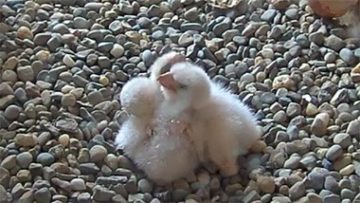By DAVID DUPONT
BG Independent News
When Chris Gajewicz was in elementary school in the early 1970s, his teacher showed his class a photo of a bald eagle. She was showing them the photo, the teacher told the class, because by the time they were adults, the bird would be extinct.
Today, eagles nest just a few miles from the naturalist’s Bowling Green home.
Laura Kearns, a wildlife biologist with the Ohio Department of Natural Resources’ Division of Wildlife, described the eagles and their fellow raptors, including falcons and hawks as an environmental success story, during a presentation at the Simpson Building, hosted by the city Parks and Recreation Department.
“There was a time when bald eagles were in serious danger of going extinct,” Kearns said.
The pesticide DDT that was “used to help grow our crops” had worked its way into the environment. The chemical made its way up the food chain starting with the insects it targeted to birds who ate those insects and then larger birds who ate those birds. “It didn’t kill the birds right off, but it would cause the eggs to be too thin so they would break before they could hatch,” Kearns said.
In the 1960s, DDT was banned, and then the Endangered Species Act was passed a few years later, and conservation practices put in place.
By the mid-1990s, this resulted in a perceptible increase in the number of bald eagles, and then in early 2000 the population “really took off” with an average annual population growth of 8.5 percent in the U.S. “It’s a pretty amazing recovery,” she said. “This is really one of the greatest conservation success stories of our time.”
The current population is about 72,000 in the lower 48 states, and 70,000 in Alaska. The bird was removed from the national endangered species list in 2007.
This was made possible by banning DDT, and then active conservation efforts.
Nests were monitored. If biologists found a nest with three eggs, they would remove one and put it in a nest that only had one. Kearns said that often a third chick in a nest would not survive.
Also injured eagles or orphaned eaglets were taken in and rehabilitated.
Kearns said she first encountered an eagle at an environmental center where she was working. She tended an injured eagle who was on display.
Ohio’s eagle population growth has also boomed, Kearns said. Now surveys finds a hundreds of mature and juvenile eagles, while 20 years ago only about 100 total where found.
There are now about 350 nests in throughout state, including two in a parking lot at Magee Marsh.
While no longer on the endangered species list, eagles are still protected. The ODNR works with landowners who have eagle nests on their property to give the eagles the space they need.
Kearns said she’s “blown away” every time she goes out to count nests. “It completely astounds me how well they’re doing.”
They still face dangers, though, she said.
Wind turbines kill eagles as well as other birds and bats, she said. Eagles die from lead poisoning, most often from ingesting shot in deer carcasses left in the woods.
Collisions with power lines are fatal to all birds. Utility companies are placing objects on the lines to make them more visible to birds.
Vehicles also take their toll, especially among younger eagles feeding on road kill.
Rehabilitation specialists are also finding eagles suffering from West Nile Virus, a mosquito borne illness introduced to the country about 20 years ago.
“There are still concerns,” she said.

Peregrine falcons were also affected by DDT, and the approach to reviving the species was much the same. However, at that time, falcons, which make their nests on cliffs where they can dive down and snatch birds out of the air, were not found in Ohio, Kearns said.
But the Eastern Peregrine Recovery Plan decided to see how falcons would do in cities with their plentiful food supply of pigeons.
This was accomplished by “hacking,” taking juvenile birds and relocating them, and setting up nesting boxes in suitable places.
This was started in Akron, Columbus and Cincinnati, and soon nesting pairs established themselves there.
And the population spread including the falcons in the clocktower of the Wood County Courthouse just three blocks from the Bowling Green State University campus, the home of the Falcons.
But not all birds have had the success of raptors.
Audience member Ginger Barson noted that earlier in the day, a study was released showing one-third of the bird population in North America had disappeared. “That’s a shocking number,” Barson said. “That’s very concerning.”
Kearns said she hadn’t seen the report but said there’s a lot going. Migratory birds are facing not only long difficult journeys, but deforestation is destroying their winter homes.
The use of pesticides are killing insects that many species depend on.
And the changes wrought by global climate change pose a danger.
“We’re constantly changing the environment and some birds adapt better than others,” she said.
Those includes more power lines, cell towers, and wind turbines.
Wind energy is really complicated. “I want to support wind energy because it helps with climate change,” Kearns said. Work needs to be done to place turbines where they don’t do as much damage.
With raptors, the main source of trouble, DDT, could be identified.
Another class of birds that’s doing well is water fowl. That’s because of regulations protecting wetlands, Kearns said. She’s afraid those rules are being “dialed back.”
The lesson to be learned from the successes, she said, is that “policy is huge.”

